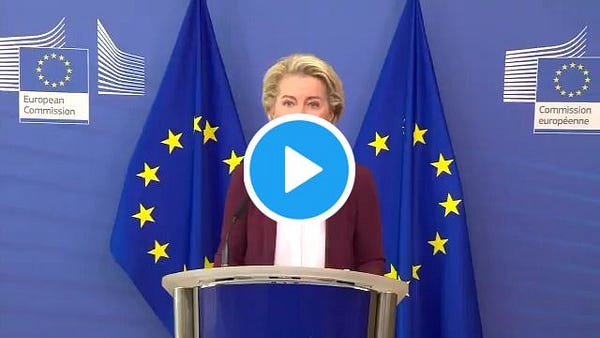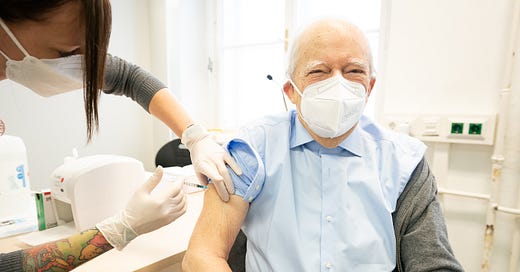Reaching Max Vax
As the daily vaccination rate begins to slow, Austria's states are looking for new ways to get the coronavirus jab into the arms of the people who need it
Servus!
Austria’s coronavirus vaccination program has passed two more important milestones. First, as of the weekend just gone, more than five million people—64.07 percent of the eligible population as of July 13—have now received their first dose of a coronavirus vaccine. Second, the country has finally surpassed the United States in terms of the percentage of the total population in receipt of their first dose. Leapfrogging America’s second dose tally can only be about a month away.
The supply issue which blighted Europe’s vaccination effort in the first quarter of 2021 has finally cleared itself up. Between January and March, Austria only received two million vaccine doses; in Q2, that number shot up to seven million. European Commission president Ursula von der Leyen announced over the weekend that the EU has managed to deliver around 500 million doses—including 330 million Pfizer/BioNTech jabs—to its member states to date. “We have delivered enough vaccines to member states to be in a position to vaccinate fully at least 70 percent of the EU adults this month,” she said Saturday.


Between July and September, Austria is due further nine million doses—more than enough to give those who have already received their first shot a second one. Austria is becoming saturated with vaccines, yet at the same time the pace of delivery is beginning to slow. On June 2, more than 140,000 doses were administered in a single day, while on last week’s peak day, Thursday, July 8, fewer than 95,000 jabs were given out. The seven-day average has fallen to around 70,000 doses per day—just as the seven-day incidence rate is beginning to creep upwards again.
Austria is now transitioning to a crucial and rather delicate phase of the vaccination campaign, one with which readers in the United States—where the vaccine dose administration rate has been in freefall since mid-April—will be familiar. The conditions on the ground are very different, of course. Austria has a small and persistent corona-skeptic movement, but nothing equivalent to the power and reach of the Republican Party and its media handmaidens. Yet the quandary is similar. The issue for Austria is no longer how to obtain vaccine doses, but rather how to get them in the arms of people who need them.
Regional variations in vaccine uptake reveal something of the problem at hand. First, uptake is far higher in cities and suburban and ex-urban areas—in the contiguous ‘eastern region’ of Vienna, Lower Austria, and Burgenland, for instance—than it is in the Mühl- and Innviertels in Upper Austria or rural areas of Carinthia and Styria. Second, within Vienna itself, there is a clear and evident divide between smaller, wealthier districts like Neubau and Währing and poorer ones like Favoriten and Rudolfsheim-Fünfhaus.



Though doctors and employers have been involved, for the most part vaccinations have hitherto taken place in large vaccination centers on an appointment-only basis as part of state-run campaigns that require pre-registration and adher to prioritization rules. For those who reside in poorly-connected rural parts of Austria, this centralization and digitization presents certain logistical challenges; for those who live in less affluent parts of Vienna for whom poverty is the thief of time, the demands the current registration and appointment process places on people represents an obstacle to vaccination. There is also the question of whether enough is being done to combat vaccine disinformation in languages other than German: Turkish, Serbo-Croatian, and so on.



As such, states are now beginning to pivot and conceive of ways of moving vaccines out of larger vaccination centers, bringing them to the people via targeted smaller venues closer to places of work, abode, or leisure. Austria’s national vaccination board has suggested vaccinations should take place over the summer at markets, in parks, at swimming pools, by lakes and popular hiking spots, at open-air cinemas, in social housing developments—even in cemeteries. The Delta variant now represents almost two-thirds of coronavirus cases in Austria, and the need to stave off the fourth wave is so urgent that no option, however strange, can be considered off the table.
Bis bald!
Thank you for signing up to the Vienna Briefing. If you know someone who would be interested in receiving this newsletter, consider sharing it with them today.
Baby Bump
Sebastian Kurz and his partner, Susanne Their, are expecting their first child. The baby is due at the beginning of December, the chancellor announced this weekend. Rumors abound about a possible wedding in the coming months.
Comrades Clash
Social Democratic Party leader Pamela Rendi-Wagner compared Burgenland governor Hans-Peter Doskozil to Freedom Party boss Herbert Kickl, condemning him as “destructive” days after Doskozil attacked her leadership of the SPÖ, one he characterized as directionless.
And Finally—
A 68-year-old woman in Vienna was forced to call the police Thursday evening after discovering a snake in her toilet. Viennese animal rescue were able to free the one-meter-long python. This was the second incident involving someone discovering a snake in their toilet in Austria within the same week.








